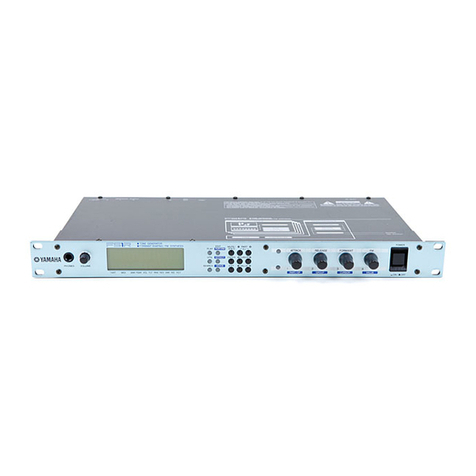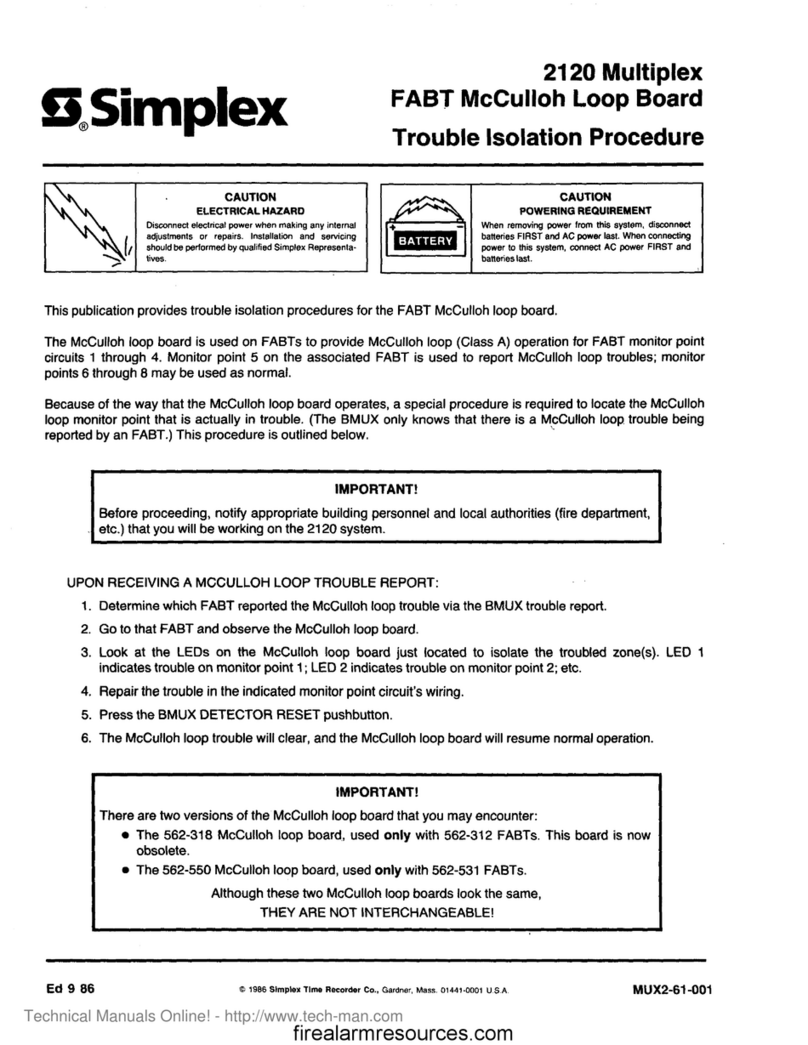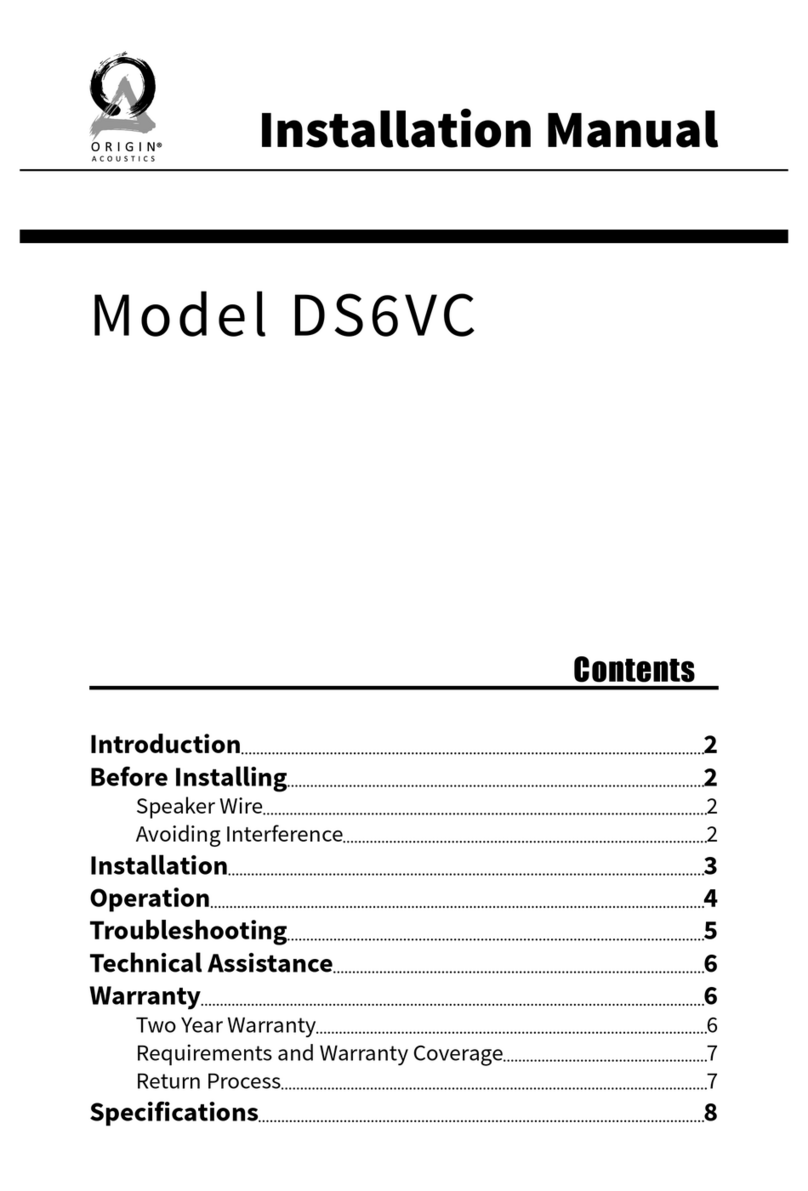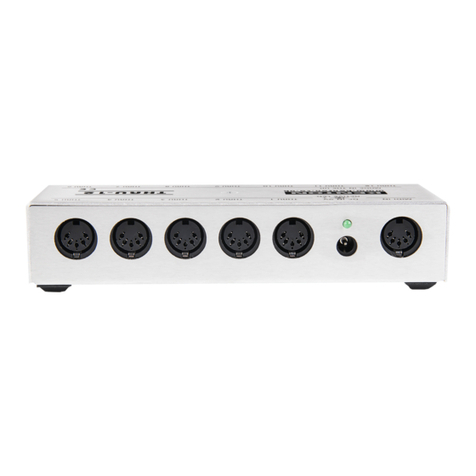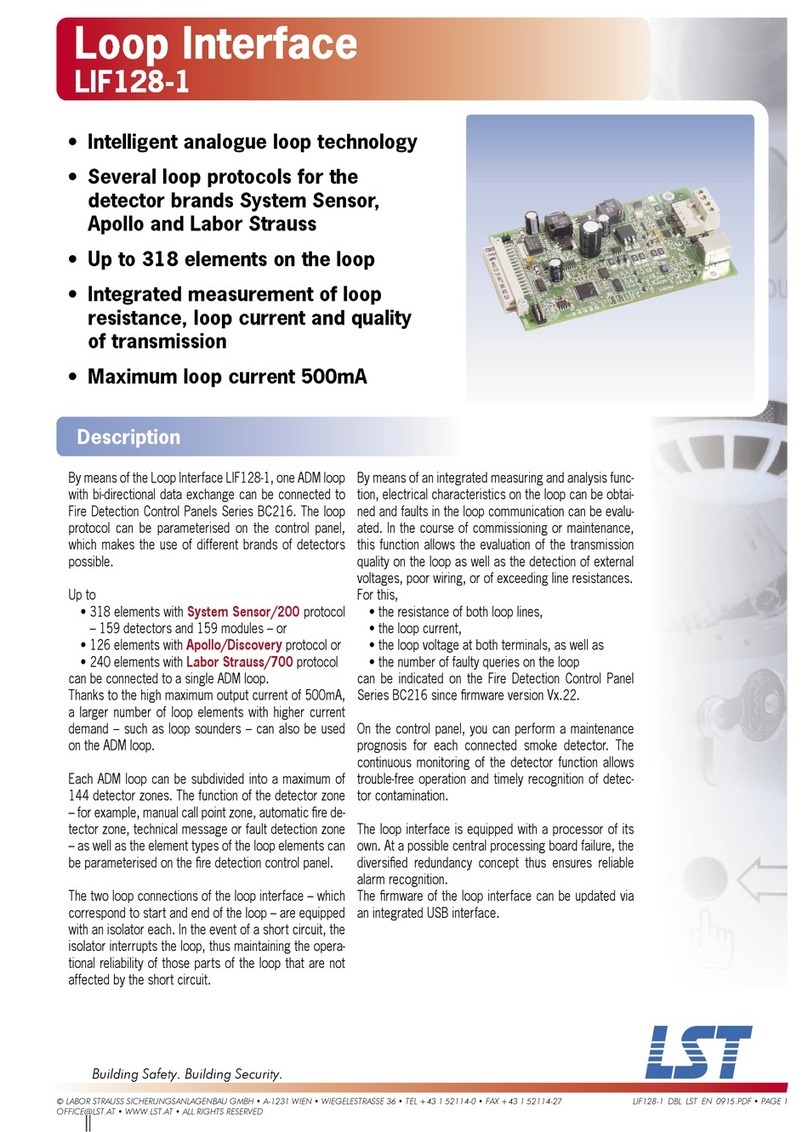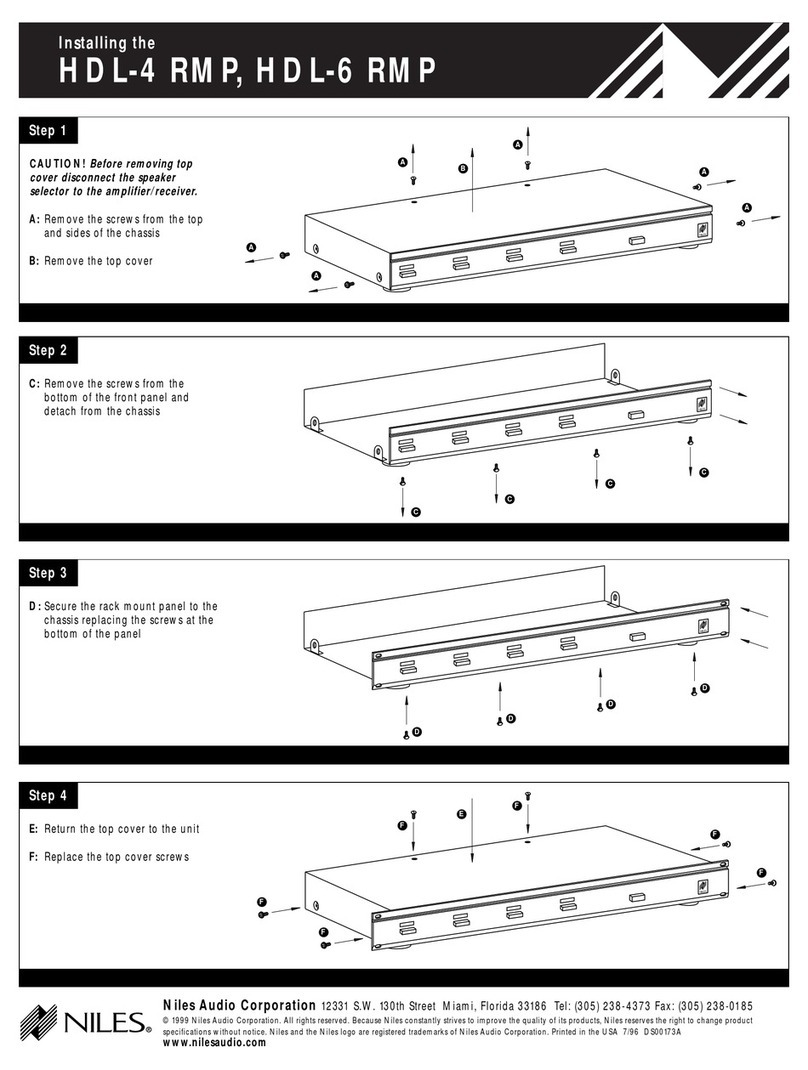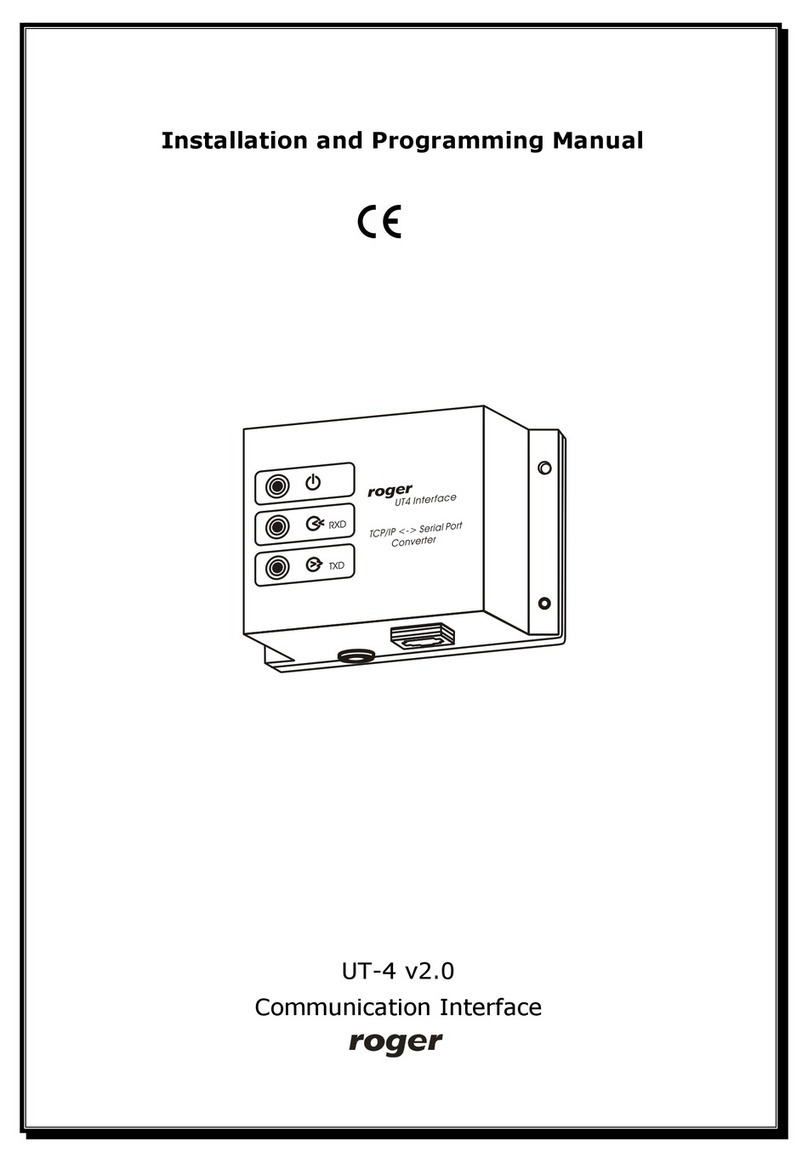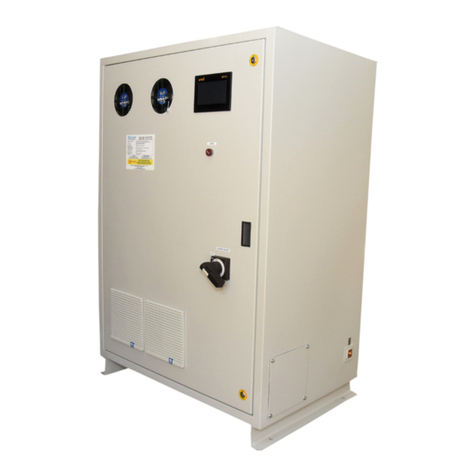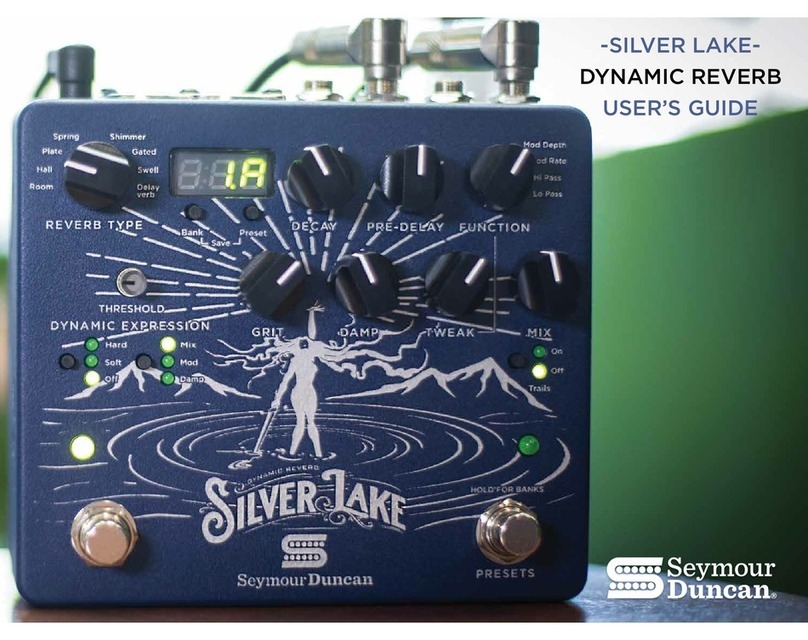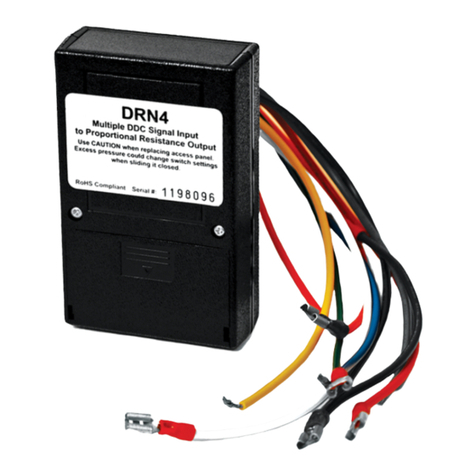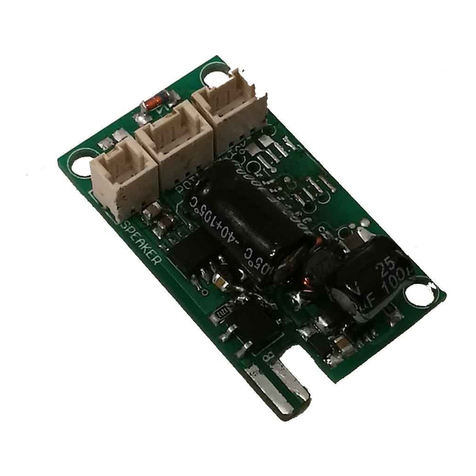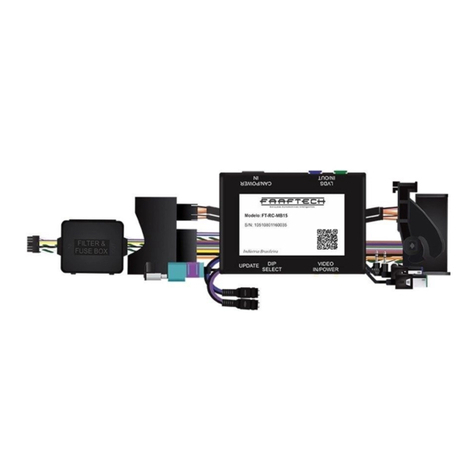Viscount CM-100 User manual

Page 1
VISCOUNT CM-100 Pipe Organ Module
ENGLISH
Dear Customer,
Thank you for choosing the VISCOUNT CM-100 sound module. The Company, a world leader in the
construction of fine classical organs, has installed in the CM-1000 the latest and most sophisticated
technology dedicated to the high fidelity reproduction of pipe organ sounds, with impressive flexibility and
remakable quality of timbre.
After years of research exploring musical synthesis techniques, our Research and Development unit, is
the FIRST in the world to create the sounds of a pipe organ by using the "physical modeling technology"
upon which the ACCUPIPE is based.
Instead of using "sound samples" from pipe organs (previously the standard method) this revolutionary
sound generation system involves the real-time calculation of the waveform generated by a precise
mathematical model based on the sound emission physics of
a pipe organ, incorporating the principal physical parameters
ie. construction geometry, materials used, and pertaining air
pressure, etc.
The fact that the simple reproduction of memorized "sound"
has been disregarded, permits the achievement of
unimaginable realism, with the level of detail previously only
created by a traditional pipe organ.
For example, the mathematical model allows the production of
a different sound for each key since it provides the virtual
reproduction of the original instrument by assigning a different
pipe to each note, similar to a pipe organ.
Furthermore, it will generate a different sound for each
consecutive pressure of the same note, thus simulating the
precise condition of the air volume inside the pipe as it is
pressed.
The CM-100 also permits the "physical" editing of the sounds produced, by adjusting the parameters -
just as the organ builder constructs the pipes. If however, "editing" is not your forte, you may choose your
sound from a library of 176 different pre-programmed pipe organ voices already in the module's memory.
To conclude we suggest that you visit our web-site: www.viscount-organs.com where you will find
information, updates and news about of the CM-100, together with details about our unique range of
instruments.
viscount
Classic Organs Division
INTRODUCTION
INTRODUCTION

VISCOUNT CM-100 Pipe Organ Module
Page 2
ENGLISH
Switching on and off
When switching the module on and off, make sure that the audio amplification system is switched off first:
this will prevent signal peaks which may damage speaker components and people's hearing.
Connecting and preventing interference
For the connections to your sound system, see sections 1.3 and 1.4
Use quality cables and remember to check their condition regularly. Do not install too close to radio
equipment, cell-phones, or devices which may generate interference. Also check that the installation site
is not subject to industrial interference, strong RFI or power blackouts.
Protection and maintenance
When transporting the instrument, protect it by using the original packaging or a suitably padded bag.
Avoid prolonged exposure to direct sunlight, intense heat sources, strong vibrations and especially damp
or dusty environments or rain, since they may cause malfunctions, deterioration and even electric
shocks.
If the instrument is to be unused for some time, protect it from dust and disconnect the power supply
cable. Any dust which does collect on the module can be removed "dry" by using a soft cloth or a brush.
Never use methylated spirits, acetone or solvents of any kind.
In case of malfunction
All the settings which can be made by the user are easily accessible on the outside of the instrument.
The instrument has no internal parts which may be replaced or adjusted in any way by customers. In
case of malfunction, contact only an authorised service centre.
Notes about the instruction manual
Read all the information provided in this manual carefully. You will avoid wasting time and will obtain the
best performance from your instrument. Some illustrations and display pages are purely guideline and
may differ from the model you have purchased.
While the instrument's essential characteristics remain the same, the manufacturer reserves the right to
make any modifications to parts, details or accessories considered appropriate to improve the product or
for requirements of a construction or commercial nature, at any time and without undertaking to update
this publication immediately.
Disclaimer
The manufacturer and its authorised dealers do not accept any liability with regard to the use or application of the products
described in this documentation, and cannot be held responsible for any damage incurred by the client further to improper use
of, or modifications to, the instrument.
Any references to names, products and companies are for the sole purpose of illustrating the use of the products described
herein. Any names, logos and brands referred to belong to their respective owners.
© 2005. All rights reserved; the reproduction of any part of this manual, in any form, without the manufacturer's specific written
permission is forbidden.
WARNINGS
WARNINGS

Page 3
VISCOUNT CM-100 Pipe Organ Module
ENGLISH
1. CONTROLS AND CONNECTIONS
1. CONTROLS AND CONNECTIONS
1.1 Description of the front p
1.1 Description of the front panel
anel
o
o
o
o
o
o
o
o
o
o
VOICE key: Selection key used to access the menus for modifying everything relating to the voice, such
as the timbre parameters, replacement of voices in the stops, the levels of each voice, and so on.
SETUP key: Press this key to access the menu for modifying the CM-100's general parameters, such
as the MIDI channel, tremulant, reverb, etc. settings.
DEMO mode: In DEMO mode you can play back eight short pieces of music (which the instrument
plays without any assistance from you) to demonstrate the instrument's timbre qualities: to access this
mode, press the VOICE and SETUP keys simultaneously.
DATA rotary encoder: The data input device. Once you have selected the parameter for modification
using the cursor keys, you can adjust its value by turning this knob. Turn the encoder clockwise to
increase the value, or anticlockwise to decrease.
CURSOR S,T, W, Xkeys: these buttons allow you to move the cursor around the video page on the
display and select the various parameters for modification. What's more, the Sand Tbuttons have
LEDs which come on to indicate the availability of a video page before and/or after the one displayed.
Press the relative button to display the video page you require.
ENTER key: button which confirms the selection of a function, a value or a procedure.
EXIT key: button for exiting the current video page or function. Pressing this key also aborts any
procedures in progress (where permitted).
VOLUME trimmer: regulates the instrument's general volume.
REVERB trimmer: regulates the level of the Reverb effect. When the trimmer is turned to the minimum
(lowest) setting, the effect is disabled.
SET key: Press this key to enable the saving of VOICE MEMORIES (see next point).

VISCOUNT CM-100 Pipe Organ Module
Page 4
ENGLISH
VOICES MEMORY keys (from 1 to 8). Press these keys for easy recall of 8 stop (voice) setups saved
earlier by the user. The CM-100 offers a total of 64 memories divided into 8 banks of 8 memories
each. For more information about use of the voice memories, see chapter 4.
CANCEL key. "Clear" button: press this key to switch off all the voices which may be on.
WHOLE / SPLIT key. Sets the sound module's operating mode. When the key LED is off, the CM-100
is set in WHOLE mode, in which all the voices respond to the same MIDI channel (single manual
mode). Press the key to switch on the LED and activate SPLIT (multi-manual) mode, in which the
instrument is able to respond to more than one MIDI channel, each channel associated to one or more
voices. Press the key again to switch off the LED and revert to whole mode. See chapter 3 for more
informations.
TREMULANT key: activates (LED on) and deactivates the tremulant effect.
VOICE REGISTERS (1 to 12) . Press these keys to switch the single voice on (press the lower part)
or off (by pressing the upper part). Note that, as CM-100 is a fully programmable device, the voices
installed (and therefore the labels of the keys) may change.
o
o
o
o
o

Page 5
VISCOUNT CM-100 Pipe Organ Module
ENGLISH
1.2 Description of the rear p
1.2 Description of the rear panel
anel
o
o
o
o
o
o
POWER ON: On/off switch
AC INPUT connector: connect the power supply lead supplied with the instrument to this connector.
The CM-100 is able to operate on power supply voltages from 90 to 250 Volts AC.
OUTPUTS connectors (from 1 to 6). Line outputs from which the audio signal can be collected to be
sent to amplified sound diffusion systems, or any amplification system of any kind. For the best instru
ment audio performance and for high-fidelity reproduction of the acoustic panorama generated by the
windchests, it is absolutely essential to connect the outputs consecutively, always starting from output
number 1. For the same reason, it is very important to take care when positioning the Loudspeaker,
as described in point 1.4 of this manual.
PHONES connector: jack 5” 1/4 socket to which a headphone set (not supplied) can be connected. It
is important to use good quality headphones, with impedance of at least 16 Ohm
EXP. PED connector: use this jack socket to connect an expression pedal (not supplied) to the CM-
100. To assure good results, use linear response expression pedals having impedance of 22 Kohm,
and fitted with stereo jack connector. For calibration operations, use the "EXP.PEDAL" settings (system
environment)
MIDI (IN, OUT and THRU) connectors: five-pin DIN connectors for connection of instruments with MIDI
interface. The IN connector allows reception of MIDI data generated by remote MIDI sources, the OUT
connector transmits the MIDI messages generated by the CM-100, and the THRU connector transmits
exactly the MIDI data received by the IN connector.
RS-232 connector. Serial connector for connecting the CM-100 to a computer running the “Viscount
Organ Editor” Software

VISCOUNT CM-100 Pipe Organ Module
Page 6
ENGLISH
1.3 Connections
1.3 Connections
Connect the power supply lead supplied with the instrument to the CM-100's A.C. input connector (rear
panel). Then connect the other end of the lead to the mains plug.
Now connect the Loudspeaker boxes (or the amplification system) to the OUTPUTS connectors on the
CM-100's rear panel.
If you have two diffusers (system recommended minimum) connect them to outputs 1(leftdiffuser) and
2(right diffuser). If you have more than two loudspeaker boxes, read the next point carefully.
If you wish to listen to the instrument using headphones, connect them to the Phones output provided.
Remember that connecting the headphones does not cut out any diffusers connected.
Now use a MIDI cable to connect the MIDI OUT connector of your organ (or keyboard) to the CM-100's
MIDI IN connector.

Page 7
VISCOUNT CM-100 Pipe Organ Module
ENGLISH
The fundamental connections have been made and the CM-100 is ready to be switched on.
However, the interfacing options available do not end here: the instrument can be included in complex
MIDI networks or connected to sequencers, computers or other devices.
1.4 Positioning the loudspeaker boxes
1.4 Positioning the loudspeaker boxes
As mentioned in point 1.2, one of the key features of the CM-100 is the implementation of special
algorithms that reproduce the acoustic panorama generated by the windchests of a pipe organ.
To ensure that this reproduction is of the highest possible fidelity, it is of fundamental importance for the
loudspeaker boxes to be connected and placed correctly, as shown below
2 boxes configuration or connection to the organ’s amplification (ouputs 1 and 2)
- 3 boxes configuration (outputs 1,2 and 3)

VISCOUNT CM-100 Pipe Organ Module
Page 8
ENGLISH
- 4 boxes configuration (outputs 1, 2, 3 and 4)
- 6 boxes configuration (outputs 1, 2, 3, 4, 5 and 6)
- 5 boxes configuration (outputs 1, 2, 3, 4 and 5)

Page 9
VISCOUNT CM-100 Pipe Organ Module
ENGLISH
The CM-100 offers a number of setup parameters for each output, as well as a range of windchest
customisation possibilities: refer to the next chapters for more informations
2.1 Main Page
2.1 Main Page
After making all the necessary connections, switch on the instrument by pressing the POWER ON button
on the rear panel.
The instrument will display the initial page, which carries the name of the instrument and the release of
the operating system (Op.System) currently installed in the form of two numbers separated by a dot.
After a few moments, the display will automatically switch to the main page.
containing the following parameters:
2. MAIN PAGE and DEMO MODE
2. MAIN PAGE and DEMO MODE
PIPE ORGAN VOICES MODULE Op.System
Accupipe Technology 1.10
M.BANK:1 ENSEMBLE:2 TRANSP.:+1 TUNE: 0
TEMPERAMENT:Equal STATUS:Finish1
M. BANK (Memory Bank) : this parameter can be used to select one of the eight memory banks, each
of which contains 8 different voice memories (buttons underneath the stops).
As well as providing a total of 64 memories, this function is especially important if the instrument is
used by more than one organist, since each of them will be able to save his or her own settings in a
different Memory Bank.
ENSEMBLE: this parameter can be used to set eight levels of natural differences in pitch which occur
in reality between one organ pipe and another: in other words, it is possible to accentuate the "tuning
error" that occurs in the organ's pipes due to wear over time and variations in temperature. The values
range from - (pipes perfectly tuned) to 8 (maximum pitch instability).
TRANSP. (Transposer): sets the transposition of the instrument's key within a range of +5/-6 semi-
tones. Set on 0 for no transposition.
TUNE: allows adjustment of the fine tuning of the instrument within a range of +/- 50 cents (hundredths
of a semitone).
TEMPERAMENT: this parameter allows the selection of a series of historic temperaments of different
eras and national origins. You can choose from EQUAL, a temperament with perfect tuning, then
WERCKMEISTER, KIRNBERGER, KELLNER, VALLOTTI, CHAUMONT, MEANTONE and
PYTHAGOREAN
STATUS: the status parameter allows you to select 4 memories containing all the instrument's settings,
known as "Finishes". These 4 finishes, known as "Finish1", "Finish2", "Finish3" and “Finish4” allow you
to save all the instrument's main performance and timbre parameters, such as the pitch, temperament,
voice parameters, and so on. When a parameter is modified, it will automatically be saved in the current
finish: to confirm that it has been saved, two asterisks (*) will appear on either side of the name of the
finish. For more information about the use and saving of the finishes and restoration of the original
finishes, see chaper 4.5
o
o
o
o
o
o

VISCOUNT CM-100 Pipe Organ Module
Page 10
ENGLISH
The procedure for modifying these parameters is easy and intuitive:
Use the cursor S,T, W, Xkeys to locate on the value of the parameter you wish to modify (the field will
start to flash), then turn the encoder to enter the value you require.
Remember that turning the encoder clockwise increases the value, while turning it anticlockwise
decreases the value.
The instrument will adopt the value entered and automatically save it in the current finish.
A BRIEF NOTE ON TEMPERAMENTS
In the "natural" tuning system, based on the acoustic phenomenon of harmonic sounds, two important musical
intervals, the major third and the perfect fifth, cannot be made to coexist in the "pure" state (i.e. beat-free).
Therefore, over the centuries a variety of compromise solutions known as TEMPERAMENTS have been
invented and realised. These give priority to one or the other interval by modifying them in various ways.
In the ancient world and the Middle Ages, until the last few decades of the 17th Century, the "Pythagorean"
tuning system, in which the fifths were retained perfectly pure, was in use. The resulting major third was
particularly unattractive in sound, and was therefore treated as a dissonance. However, the music of the time
was mainly monodic, and the early forms of vocal and instrumental polyphony made a great deal of use of the
interval of a fifth. With the early Renaissance, and the start of the great flowering of vocal polyphony, the
interval of a major third gradually came to be heard as consonant and not dissonant. The instruments with fixed
tuning, such as the organ and harpsichord, gradually adapted to this situation by adopting a system of
temperament known as "Meantone", which gave the major third priority over the fifth. This temperament is
particularly important because it was the temperament in normal use in Europe in the 16th and 17th Centuries,
until the early 18th Century. Here are the six temperaments available on the CM-100
WERCKMEISTER: This temperament, invented by the organist and musical theorist Andreas Werckmeister, is
recommended for performing the German musical repertoire of the late 1600s
KIRNBERGER:This temperament, developed by Johann Philipp Kirnberger, pupil of J.S. Bach, is suitable for
playing the German Baroque composers and the works of Bach.
KELLNER:Herbert Anton Kellner, born in Prague in 1938, studied physics, mathematics and astronomy at the
University of Vienna. In 1975, his research enabled him to identify the unequal temperament of the same name,
used by Bach for his "Well-Tempered Clavier". Suitable for 18th Century German music and the music of Bach
in particular.
VALLOTTI: This Italian temperament invented by Francescantonio Vallotti was later taken up in England by
Thomas Young. It can be used effectively for the Italian 18th Century repertoire, and also for the English
repertoire of the same period.
CHAUMONT (1696) :It is based on six pure major thirds: D-F# / E-G# / F-A / G-B / A-C# / C-E (the last one
slightly diminished). It can be used mainly for French music composed between the end of the 17th and the
beginning of the 18th Century.
MEANTONE:
- 8 pure major thirds: E flat - G / B flat - D / F - A / C - E / G - B / D - F # / A - C# / E - G.
- 4 unusable major thirds (diminished fourths): B - D# / F# - A# / C# - E# / A flat - C.
- 1 fifth known as the "wolf" (very dissonant extended fifth): A flat - E flat.
- Highly irregular chromatic scale (meaning that chromatic compositions are given a very distinctive voice)
- Keys usable with this temperament: C maj. / D maj. / G maj. / A maj. / B flat maj. and the relative minors.
PYTHAGOREAN: In this temperament, all the fifths are natural except for the "wolf" fifth, in the interval A flat
- E flat, which is greatly diminished.
It dates from the Middle Ages up to the 15th century, and can therefore be used for compositions of that
period.

Page 11
VISCOUNT CM-100 Pipe Organ Module
ENGLISH
2.2 Display Messages
2.2 Display Messages
INFO MESSAGE: LINE OUTs NOT CONNECTED
press EXIT
WARNING: LINE OUTs HAVE TO BE CONNECTED
CONTIGUOSLY (1 to 6) press EXIT
Select DEMO song with VOICE MEMORY Keys:
Select DEMO song with VOICE MEMORY Keys:
PLAYING: Pescetti_Presto [²²²²²/ ]
N.B. The instrument automatically sets the timbre suitable for performance of the demo
song selected: however, this setup can be changed while the song is playing using the
stops on the front panel.
To exit the DEMO mode, press the VOICE and SETUP keys simultaneously, or the EXIT button: in both
cases the instrument will return to the main video page
The CM-100 has detected that there are no loudspeaker boxes connected to the outputs: you can only
listen to the instrument using the headphones. Press EXIT to return to the main page
The system has detected that the loudspeakers have not been connected correctly, so some outputs
might not work or might malfunction.Check the connections and make sure that they have been made
as described in point 1.4. Press EXIT to exit
2.3 Listening to the Demo songs
2.3 Listening to the Demo songs
In the CM-100 DEMO mode you can play back a number of short pieces of music, which the instrument
plays itself to demonstrate its timbre qualities (demo songs).
To access the DEMO mode, locate on the main page and press the VOICE and SETUP keys
simultaneously. The following video page will appear on the instrument's display:
There is one demo track associated to each of the VOICE MEMORY keys: simply press the key of the
demo you wish to hear and it will start to play.
The display will indicate that the selection has been made by showing the word PLAYING followed by
the name of the song and the progress bar.
At the end of the piece, the instrument returns to the demo song selection video page.
You can stop the demo at any moment by pressing the EXIT key or pressing the demo song selection
key again.

VISCOUNT CM-100 Pipe Organ Module
Page 12
ENGLISH
The association between the VOICE MEMORY keys and the demo songs is as follows
key 1: Johann Gottfried Walther - Allegro (from Concerto in F maj.)
key 2: Johann Pachelbel - Von der Geburt Christi
key 3: Domenico Zipoli - Allegretto in G min
key 4: Johann Gottfried Walther - Schmücke dich, o liebe Seele
key 5: Gio Batta Pescetti - Presto (from Sonata in C min.)
key 6: Johann Pachelbel Alle Menschen müssen sterben (Choral und Variation)
key 7: Robert Führer - Andantino in G maj
key 8: Johann Gottfried Walther - Erschienen ist der Herrliche Tag.
3. VOICE
3. VOICE SECTION
SECTION
The Voice menu contains all the functions which modify the voices of the CM-100. When the VOICE
button on the left of the instrument's display is pressed, its LED lights up and the following video page
appears on the display:
[EDIT] [CHANGE] [VOLUME] [OUT ROUTER]
[V.F.S.] [LABEL CHECK] [SORT VOICES]
Ctrbomb32 Bombard16 Bombarde8
Schawm4 Waldhrn16 Cornopea8
giving access to the various voice modification sections which, in detail, are:
oEDIT : regulates the sound generation parameters for each individual voice.
o CHANGE: replaces the voices currently active on the expander's 12 stops
oVOLUME: regulates the volume of the voices
oOUT ROUTER: selects the type of windchest to be applied to the individual voice and its
characteristics.
oV.F.S.: voices factory settings. Used to restore the voice's parameters to their original values (set in the
factory)
oLABEL CHECK: allows you to check which voice has been assigned to each of the 12 stops on the
front panel
oVOICE SORT: starts the procedure for automatic sorting of the voices in the stops.
Use the cursor keys to select the section required and press ENTER. You can exit this menu and return
to the main menu page at any time by pressing the VOICE key (the LED of which is on) or the ESC key
3.1 VOICE edit
3.1 VOICE edit
As already mentioned, the EDIT section of the voice menu gives the user access to the main timbre
parameters of the current voice to allow him to adjust it to his needs.
Press the ENTER key with the EDIT option selected to display a list of the voices currently installed in
the 12 stops. The stop currently selected flashes
Then use the CURSOR keys again to select the voice you wish to modify; you can also do this by
pressing the stop of your choice on the front panel.

Page 13
VISCOUNT CM-100 Pipe Organ Module
ENGLISH
Once the selection has been confirmed with ENTER, the display will show the relative parameter
modification page, which will differ depending on the type of voice selected. The stop which contains the
voice being modified will flash.
3.1.1 Editing the Bourdons, Princip
3.1.1 Editing the Bourdons, Principals, S
als, Strings and Flutes
trings and Flutes
If the voice selected for modification belongs to the Principals, Bourdons or flutes family, the following
page will appear on the display:
Gedackt16 Character: 0 Noise: 0
Volume: 0 Attack:0 ReleaseDet:0
Gedackt16 Character: 0 Noise: 0
Volume: 0 Attack:0 ReleaseDet:0
Making available the following fields:
o
o
o
o
o
o
Voice being edited: The first field in the top corner of the display shows the name of the voice being
edited: it can be changed by simply selecting the field (cursor keys) and turning the encoder.
The voice can be also be selected by pressing the rocker switch of the stop containing the voice
required
CHARACTER: this parameter modifies the level of the harmonics of the selected voice, but without
changing the level of the first harmonic. Changing this value makes the sound more "open" and
immediate (positive values) or more "closed" and dark (negative values)
NOISE: This parameter regulates the amount of air noise in the chosen voice. Note that thanks to the
special physical model algorithm, the value will not be evenly distributed but will have a more or less
noticeable effect on the voice depending on the pipe's footage, its characteristics and the note played
VOLUME general level of the voice
ATTACK: adjusts the voice's attack time, i.e. the time it takes to reach the maximum volume value, on
a scale of 8 values. Set 0 for the minimum attack time and 8 for the maximum time.
Note that the scale of 8 values cannot be associated to fixed time values, since this parameter depends
on the type of voice being modified and the Time Tracking of the keyboard, which means that attack
times are shorter in the upper than in the lower part.
RELEASE DETUNE: adjusts the variation in tuning when the note is released compared to the value
with the note pressed, on a scale of 8 values. Here again, fixed values of hundredths of a semitone
cannot be associated to the values shown on the screen, since the modification depends on the voice
and the part of the keyboard being played.
Set 0 for the minimum change in tuning and 8 for the maximum change.
To select the field required use the CURSOR keys, remembering that a field is selected when its value
flashes; once the field has been selected its value can be adjusted by turning the encoder.
When the modification is complete you can return to the VOICE mode main menu page by pressing the
EXIT key.
3.1.2 Editing Reeds
3.1.2 Editing Reeds
If the voice being edited belongs to the REEDS family, the display will show this page

VISCOUNT CM-100 Pipe Organ Module
Page 14
ENGLISH
Oboe8A Character: 0 Noise:-3
Volume: 0 Attack:4 FreqSkew:4
Mixture Harm.base:1 1/3 Character: 0
Volume: 0 Ranks:4 Attack:0 ReleaseDet:0
Schwebng8 Character: 0 Noise: 0
Detune:+3 Volume: 0 Attack:0 ReleaseD:0
The parameters are basically the same as described above, except for the FREQUENCY SKEW field,
which regulates the amount of the typical detuning skew the reeds cause when the note is released.
Although their names are the same, the effects and properties of the other fields vary because the
physical model applied to the sound generation changes: for example, you will notice that in reed
instruments the character will also affect the first harmonic and its effects will differ in the case of bass or
treble footage. The same applies to the noise, which has effects and timbre of a completely different kind
when applied to the reeds.
The procedure for using the section is the same: use the cursor keys to select the field for modification
and the encoder to enter the appropriate value.
Press EXIT to return to the VOICE mode main page, then the EXIT key again or the VOICE key to exit
this page.
3.1.3 Editing Mixtures
3.1.3 Editing Mixtures
The page for editing a voice in the mixtures family is as follows:
The new fields which appear in this page, typical of the "physical" conformation of a mixture voice, relate
to the HARM.BASE (Harmonic Base), which sets the basic harmonic on which the mixture voice is
created, in a range of values from 2 1/3’, 2, 1 1/3’ 1'.
As you will know, this organ voice is created by the action of several pipes arranged in ranks: the RANKS
field in this page allows you to set the number of virtual ranks on the basis of which the CM-100 will
calculate the mixture voice. The noise (air noise) parameter does not appear because the specific
"physical conformation" of the pipes which generate these voices mean that it is negligible.
As usual, use the cursor keys to select the field for modification and turn the encoder to enter the value
you consider appropriate. When the modification is complete you can return to the VOICE mode main
menu page by pressing the EXIT key.
3.1.4 Editing Detuned voices
3.1.4 Editing Detuned voices
When a detuned voice is selected for modification, the parameter editing video page will be as follows
Containing the following user fields:

Page 15
VISCOUNT CM-100 Pipe Organ Module
ENGLISH
o
o
o
o
o
o
o
Voice being edited. This is the voice being modified: it can be changed by simply selecting the field
(cursor keys) and turning the encoder, or by pressing the stop rocker key.
CHARACTER: changing this value makes the sound more "open" and immediate (positive values) or
more "closed" and dark (negative values)
NOISE: This parameter regulates the amount of air noise in a range of 8 possible settings.
DETUNE: The field used to set the amount of "detuning" to be applied to the voice: the higher the
value, the greater the "beating" effect the voice will acquire when used with other voices.
With a setting of 0 the voice is perfectly tuned with the other voices and the beating typical of "detuned"
voices will therefore not be audible
VOLUME: General level of the voice
ATTACK: adjusts the voice's attack time, that means the time it takes to reach the maximum volume
value. Set 0 for the minimum attack time and 8 for the maximum time.
RELEASE DETUNE: adjusts the variation in tuning when the note is released compared to the value
with the note pressed, on a scale of 8 values. Set 0 for the minimum change in tuning and 8 for the
maximum change.
3.1.5 Editing Cornet
3.1.5 Editing Cornets
s
The last variant added to the voice editing page concerns the cornet voices
Kornett Ranks Character: 0:3
Volume: 0 Attack:4 ReleaseDet:0
Gedackt16 Low: 0
Keyb.Scaling High: 0
As the above video page shows, the function for editing the physical parameters of the cornet voices (like
the mistures) does not include the noise parameter because of the unique construction and physical
features of this family of stops.
The noise parameter is replaced by the RANKS field (already discussed with regard to the mixture
editing function) which sets the number of virtual pipes the instrument will use to construct the cornet
sound.
As usual, use the CURSOR keys to select the field you wish to modify; after this, you will be able to adjust
its value by turning the encoder.
When the modification is complete you can return to the VOICE mode main menu page by pressing the
EXIT key.
3.1.5 Keyboard T
3.1.5 Keyboard Tracking
racking
From each of the voice editing pages examined so far, pressing the illuminated CURSOR Tbutton gives
access to the second page for editing and displaying the KEYBOARD TRACKING parameter:

VISCOUNT CM-100 Pipe Organ Module
Page 16
ENGLISH
This parameter allows you to set the scaling of the voice's volume for the upper and lower parts of the
manual.
These two zones are fundamental in providing the right timbre and often their volume has to be slightly
reduced or increased compared to the central part of the manual.
The setting parameters are therefore the following:
o LOW: regulates the attenuation (negative values) or increase (positive values) of the volume in the low
part of the manual.
o HIGH: regulates the attenuation (negative values) or increase (positive values) of the volume in the
high part of the manual.
As usual, use the cursor keys to select the field you wish to modify and turn the encoder to enter the
correct value for it.
At the end of the operation press EXIT to exit the function or the Scursor key to return to the previous
editing page.
3.2 VOICE
3.2 VOICE CHANGE
CHANGE
As already mentioned at the beginning of this manual, the CM-100 has a library of 176 organ voices
which the user can freely assign to each of the 12 stops on the instrument's front panel.
Once the voice has been assigned to a stop, it will remain in the memory until the next time it is changed.
Now let us take a detailed look at how to carry out the procedure for changing a stop's voice:
Starting from the main page, press the VOICE key. The video page with the function's menu will appear
on the display
[EDIT] [CHANGE] [VOLUME] [OUT ROUTER]
[V.F.S.] [LABEL CHECK] [SORT VOICES]
Ctrbomb32 Bombard16 Bombarde8
Schawm4 Waldhrn16 Cornopea8
Replace:CtBourd32
With:Principals press ENTER to continue
For greater convenience, the CM-100's voice library has been subdivided into families, each containing
the voices belonging to a specific type of organ pipe: these include the Principals, Bourdons, Reeds, etc.
So on the current page, turn the encoder to select the family you require and press ENTER to confirm.
(or exit to go back)
Then use the cursor keys to select the voice you wish to replace; you can also do this by pressing the
stop of your choice on the front panel.
If the selection is confirmed by pressing ENTER, the display will show
Use the cursor keys to select the CHANGE menu option, which will start to flash. Press ENTER and the
display will show the list of voices currently installed on the 12 stops: the stop currently selected will flash

Page 17
VISCOUNT CM-100 Pipe Organ Module
ENGLISH
To set the new value (expressed in dB on the display), locate the cursor on the voice required using the
CURSOR buttons or its register on the panel, and use the VALUE encoder to make the setting.
Once you have made all the changes you require, press EXIT to return to display of the VOICES menu.
The volume level here set is the same you’ll find in the EDIT section, describe at the point 3.1 of this
manual
3.4 OUT
3.4 OUT ROUTER
ROUTER function
function
One of the Acupipe technology major innovations is the capability for simulating the position of the wind-
chests and the arrangement of the pipes inside them, for every voice.
All this is achieved by setting the channelling of the audio signals, i.e. the way in which they are
distributed, on the rear outputs
Replace:CtBourd32 With:CtPrinc32
Press ENTER to replace
You can now turn the encoder to select the voice of your choice, contained in the family you choose in
the step before. Note that the name of the voices is shown in abbreviated form: the appendix to this
manual contains the name of the voice in full, its acronym, the family to which it belongs and the
consecutive number consigned to it.
Remember that when you are selecting a voice, the instrument allows you to listen to it in advance: if you
play the master instrument, you will hear the timbre of the voice currently on the display, before it is
definitively memorised.
WARNING! Tab 1 now is CtPrinc32
- Please change the label -
Gedackt16: 0 Prinzip8A: 0 Schwebng8: 0
HohlFlot8:+3 Oktave4A :-1 SptzFlot4: 0
:
In the usual way, when you press ENTER the new voice selected will replace the one present in the
selected stop. To confirm this has taken place, the display will show the following video page
reminding you that you have to physically change the label on the stop, because its contents have been
changed.
Then press EXIT to scroll back to the previous pages and make a new selection or return to the main
operating page.
3.3 Regulating the voice VOLUME
3.3 Regulating the voice VOLUME
The VOICES VOLUME function allows you to adjust the volume of each individual voice in a range from
-9 dB to +6 dB. Each modification is saved immediately and is audible in real time, making it easier for
the user to obtain the setting required.
To recall this function, select the VOLUME option from the VOICES menu; the display will show:

VISCOUNT CM-100 Pipe Organ Module
Page 18
ENGLISH
For each voice, the system is able to set an output configuration which reflects the layout of the pipes in
real wind-chests, as follows:
Wedge
Chromatic
Left Wing
Right Wing
Mono
Alternate Keys
Moreover, each of these layouts can be further specified with regard to the width of the wind-chest and
its central location in relation to the number of outputs connected.
It is important to underline that the system automatically adapts the channelling to the number of
speakers connected.
3.4.1 Short introduction to the W
3.4.1 Short introduction to the Windchest of pipe organs
indchest of pipe organs
The wind-chest is a box in which the air from a bellows is distributed. The bellows may be operated by
hand or an electric motor, and keeps the air pressurised and ensures it is uniformly distributed through
the pipes.
Normally, each manual has its own wind-chest which contains the pipes.
However, there are various types of wind-chest, which may contain a single register or have a cascade
arrangement with an organ valve (a box full of air filled by the bellows) with the branches leading off to
all the registers for each note.
The following is a short description of the wind-chests which the CM-100 simulates:
Wedge
In this configuration, the tallest, broadest pipes are located in the centre, so the voice's
lowest notes are played by the most central speakers. As the pitch rises the signal is
gradually distributed further and further to the outside, in alternation; in other words,
C will sound on the right and C# on the left.
Chromatic
This configuration is the opposite of the previous one; in this mode, the tallest,
broadest pipes are on the outside, so the lowest notes are played on the outermost
speakers, again in alternation. As the pitch rises the notes are played closer and
closer to the centre.
Left Wing
As the the drawing shows, the tallest, broadest pipes are installed on the left, so the
lowest notes are played by the speakers furthest to the left. As the pitch rises the notes
are played more and more to the right.

Page 19
VISCOUNT CM-100 Pipe Organ Module
ENGLISH
Right Wing
This layout is the reverse of the previous one, so the lowest notes sound on the right
and the highest on the left.
Alternate Keys
In this mode, the notes are sent in alternate semitones to two outputs (or a position
midway between two outputs). This means, for example, that C can always be made
to sound on output 1 and C# on output 4.
Mono
This setting allows the sound of a voice to be sent to a single output, or a position midway
between two outputs. This means that regardless of the point on the keyboard, the voice
always sounds from the same position..
3.4.2 W
3.4.2 Windchest Settings
indchest Settings
The editing section which contains the virtual windchest settings is called OUT ROUTER.
From the voice menu (accessed using the panel key provided) use the cursor keys to select the above
field and press Enter. The following page will be made available on the display:
The first field in the top right-hand corner identifies the voice being edited, meaning the voice to which
the windchest is to be assigned: it can be changed by selecting the field with the cursor keys (when the
voice is selected, it flashes) and turning the encoder.
The second field, called Windchest, in the bottom left-hand corner allows you to select the windchest on
the following basis:
Windchest = 0: Wedge
Windchest = 1: Chromatic
Windchest = 2: Left wing
Windchest = 3: Right wing
Windchest = 4: Mono output
Windchest = 5: Alternate notes
The central part of the display shows a diagram of the selected windchest (bottom line) and its distribution
across the speakers currently connected (top line)
Gedackt16 1 2 3 Width:15
Windchest:0 Center: 8

VISCOUNT CM-100 Pipe Organ Module
Page 20
ENGLISH
For example, if only two speakers are connected, they will be shown as follows:
Gedackt16 1 2 Width:15
Windchest:0 Center: 8
Gedackt16 1 2 3 Width:15
Windchest:0 Center: 8
Gedackt16 no line out Width:15
Windchest:0 Center: 8
Gedackt16 wrong line out Width:15
Windchest:0 Center: 8
Gedackt16 1 2 3 Width:15
Windchest:2 Center: 8
Gedackt16 1 2 3 Width: 9
Windchest:2 Center: 8
If there are 3 speakers, the instrument automatically redistributes the windchest effect in the new
configuration, so speaker 2 will carry the central part of the panorama and the third the left part. On the
display the new situation will be shown as follows:
and the message "no line outs”
indicates that, at present, there are no speakers connected and therefore the windchest will not be
activated. Similarly, the message " wrong line out":
informs the user that the speakers have not been connected in accordance with the rule that the first
speaker must always be connected to output 1 proceeding in consecutive sequence, leaving no gaps
between two connected speakers.
The parameters on the right-hand side of the display are the parameters for adjustment of the active
windchest, and their function changes depending on its physical characteristics.
For central peak and wing windchests (all versions), the parameters available relate to the Width of the
windchest and the position of its Centre within the acoustic panorama created by the speakers
connected.
As an example, let us take a left-hand wing windchest
If we reduce the value of the Width field (selected using the cursor keys) we will see that the windchest
becomes narrower, and therefore the sound of the stop will be re-allocated within the acoustic panorama:
in this case, it will no longer be present on outputs 1 and 3.
Other manuals for CM-100
1
Table of contents
Other Viscount Recording Equipment manuals

